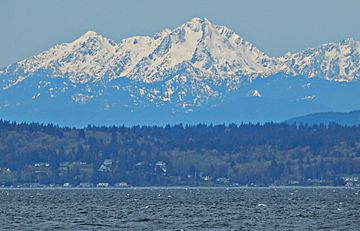Mount Washington (Olympics) facts for kids
Quick facts for kids Mount Washington |
|
|---|---|

Mount Washington seen from Seattle
|
|
| Highest point | |
| Elevation | 6,260 ft (1,908 m) |
| Prominence | 2,615 ft (797 m) |
| Geography | |
| Parent range | Olympic Mountains |
| Topo map | USGS Mount Washington |
| Climbing | |
| Easiest route | Route 1A from the Olympic Mountains Climbing Guide provides a direct approach with few route finding difficulties. |
Mount Washington is a tall peak in the Olympic Mountains of Washington state. It stands about 6,260-foot-tall (1,910 m). This impressive mountain is found within the Mount Skokomish Wilderness.
Contents
Understanding Mount Washington's Climate
Mount Washington is located in a special climate zone called the marine west coast climate. This means it gets a lot of influence from the nearby Pacific Ocean.
How Weather Reaches the Mountain
Most of the weather that affects Mount Washington starts over the Pacific Ocean. These weather systems, called weather fronts, usually travel northeast towards the Olympic Mountains.
As these weather fronts get closer to the Olympic Mountains, they are forced to rise higher into the sky by the tall peaks. When the air rises, it cools down. This cooling causes the moisture in the air to turn into rain or snow. This process is known as Orographic lift.
Rain, Snow, and Sunshine
Because of this "mountain lift" effect, the Olympic Mountains get a lot of rain and snow. This is especially true during the winter months. During winter, the weather is often cloudy.
However, in the summer, large areas of high air pressure form over the Pacific Ocean. These high-pressure systems often bring clear skies to the mountains. So, there is usually little or no cloud cover during the summer.
Snow and Safety
Because of the ocean's influence, the snow on Mount Washington tends to be wet and heavy. This type of snow can increase the risk of avalanches. An avalanche is a sudden, fast-moving slide of snow down a mountain.
Water Flow from the Mountain
The rain and melted snow that runs off Mount Washington eventually flows into two main rivers. These are the Hamma Hamma River and the Skokomish River.




